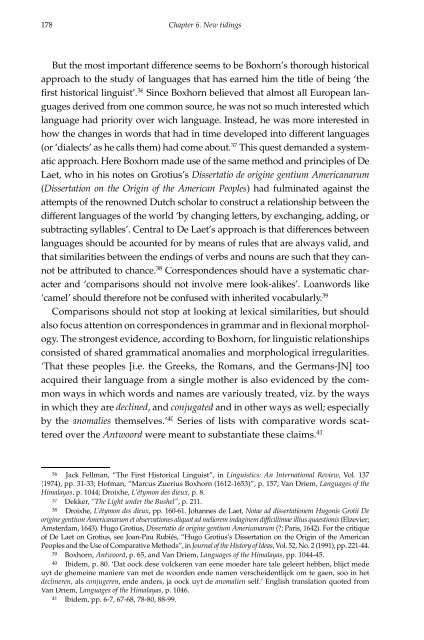historical and political thought in the seventeenth - RePub - Erasmus ...
historical and political thought in the seventeenth - RePub - Erasmus ...
historical and political thought in the seventeenth - RePub - Erasmus ...
Create successful ePaper yourself
Turn your PDF publications into a flip-book with our unique Google optimized e-Paper software.
178<br />
Chapter 6. New tid<strong>in</strong>gs<br />
But <strong>the</strong> most important difference seems to be Boxhorn’s thorough <strong>historical</strong><br />
approach to <strong>the</strong> study of languages that has earned him <strong>the</strong> title of be<strong>in</strong>g ‘<strong>the</strong><br />
first <strong>historical</strong> l<strong>in</strong>guist’. 36 S<strong>in</strong>ce Boxhorn believed that almost all European languages<br />
derived from one common source, he was not so much <strong>in</strong>terested which<br />
language had priority over wich language. Instead, he was more <strong>in</strong>terested <strong>in</strong><br />
how <strong>the</strong> changes <strong>in</strong> words that had <strong>in</strong> time developed <strong>in</strong>to different languages<br />
(or ‘dialects’ as he calls <strong>the</strong>m) had come about. 37 This quest dem<strong>and</strong>ed a systematic<br />
approach. Here Boxhorn made use of <strong>the</strong> same method <strong>and</strong> pr<strong>in</strong>ciples of De<br />
Laet, who <strong>in</strong> his notes on Grotius’s Dissertatio de orig<strong>in</strong>e gentium Americanarum<br />
(Dissertation on <strong>the</strong> Orig<strong>in</strong> of <strong>the</strong> American Peoples) had fulm<strong>in</strong>ated aga<strong>in</strong>st <strong>the</strong><br />
attempts of <strong>the</strong> renowned Dutch scholar to construct a relationship between <strong>the</strong><br />
different languages of <strong>the</strong> world ‘by chang<strong>in</strong>g letters, by exchang<strong>in</strong>g, add<strong>in</strong>g, or<br />
subtract<strong>in</strong>g syllables’. Central to De Laet’s approach is that differences between<br />
languages should be acounted for by means of rules that are always valid, <strong>and</strong><br />
that similarities between <strong>the</strong> end<strong>in</strong>gs of verbs <strong>and</strong> nouns are such that <strong>the</strong>y cannot<br />
be attributed to chance. 38 Correspondences should have a systematic character<br />
<strong>and</strong> ‘comparisons should not <strong>in</strong>volve mere look-alikes’. Loanwords like<br />
‘camel’ should <strong>the</strong>refore not be confused with <strong>in</strong>herited vocabularly. 39<br />
Comparisons should not stop at look<strong>in</strong>g at lexical similarities, but should<br />
also focus attention on correspondences <strong>in</strong> grammar <strong>and</strong> <strong>in</strong> flexional morphology.<br />
The strongest evidence, accord<strong>in</strong>g to Boxhorn, for l<strong>in</strong>guistic relationships<br />
consisted of shared grammatical anomalies <strong>and</strong> morphological irregularities.<br />
‘That <strong>the</strong>se peoples [i.e. <strong>the</strong> Greeks, <strong>the</strong> Romans, <strong>and</strong> <strong>the</strong> Germans-JN] too<br />
acquired <strong>the</strong>ir language from a s<strong>in</strong>gle mo<strong>the</strong>r is also evidenced by <strong>the</strong> common<br />
ways <strong>in</strong> which words <strong>and</strong> names are variously treated, viz. by <strong>the</strong> ways<br />
<strong>in</strong> which <strong>the</strong>y are decl<strong>in</strong>ed, <strong>and</strong> conjugated <strong>and</strong> <strong>in</strong> o<strong>the</strong>r ways as well; especially<br />
by <strong>the</strong> anomalies <strong>the</strong>mselves.’ 40 Series of lists with comparative words scattered<br />
over <strong>the</strong> Antwoord were meant to substantiate <strong>the</strong>se claims. 41<br />
36 Jack Fellman, “The First Historical L<strong>in</strong>guist”, <strong>in</strong> L<strong>in</strong>guistics: An International Review, Vol. 137<br />
(1974), pp. 31-33; Hofman, “Marcus Zuerius Boxhorn (1612-1653)”, p. 157; Van Driem, Languages of <strong>the</strong><br />
Himalayas, p. 1044; Droixhe, L’étymon des dieux, p. 8.<br />
37 Dekker, “The Light under <strong>the</strong> Bushel”, p. 211.<br />
38 Droixhe, L’étymon des dieux, pp. 160-61. Johannes de Laet, Notae ad dissertationem Hugonis Grotii De<br />
orig<strong>in</strong>e gentium Americanarum et observationes aliquot ad meliorem <strong>in</strong>dag<strong>in</strong>em difficillimae illius quaestionis (Elzevier;<br />
Amsterdam, 1643). Hugo Grotius, Dissertatio de orig<strong>in</strong>e gentium Americanarum (?; Paris, 1642). For <strong>the</strong> critique<br />
of De Laet on Grotius, see Joan-Pau Rubiés, “Hugo Grotius’s Dissertation on <strong>the</strong> Orig<strong>in</strong> of <strong>the</strong> American<br />
Peoples <strong>and</strong> <strong>the</strong> Use of Comparative Methods”, <strong>in</strong> Journal of <strong>the</strong> History of Ideas, Vol. 52, No. 2 (1991), pp. 221-44.<br />
39 Boxhorn, Antwoord, p. 65, <strong>and</strong> Van Driem, Languages of <strong>the</strong> Himalayas, pp. 1044-45.<br />
40 Ibidem, p. 80. ‘Dat oock dese volckeren van eene moeder hare tale geleert hebben, blijct mede<br />
uyt de gheme<strong>in</strong>e maniere van met de woorden ende namen verscheidentlijck om te gaen, soo <strong>in</strong> het<br />
decl<strong>in</strong>eren, als conjugeren, ende <strong>and</strong>ers, ja oock uyt de anomalien self.’ English translation quoted from<br />
Van Driem, Languages of <strong>the</strong> Himalayas, p. 1046.<br />
41 Ibidem, pp. 6-7, 67-68, 78-80, 88-99.

















